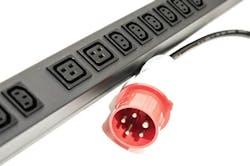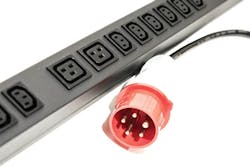Power distribution and monitoring getting more sophisticated in data centers
By Patrick McLaughlin
In both personal and professional endeavors, today more than ever, progress and status are quantitative. Metrics, KPIs (key performance indicators) and dashboards are everywhere. From a personal standpoint, they are a daily report of everything from the number of steps an individual takes to the percentage-funding level of a retirement account. From a business standpoint, metrics, KPIs and dashboards keep us apprised of everything from how revenue stacks up year-over-year to the amount of electricity each piece of networking equipment consumes. In a data center, that last metric carries significant weight. To that end, providers of power distribution units (PDUs) used in data centers have added capabilities to these devices that increase the visibility and transparency of network devices’ power consumption. This article will review some recent innovations that do so.
In mid-2016 Siemon introduced the PowerMax PDU product line to markets outside of North America. The line of products is currently under review by Underwriters Laboratories (UL) and, pending UL’s anticipated approval within months, the line will be made available in North America as well. Products in the PowerMax line range from basic and metered PDUs to a full line of intelligent PDUs that deliver real-time power information with varying degrees of intelligent functionality, Siemon said.
“Available in both single phase and three phase power for efficiently powering active equipment in today’s data centers, PowerMax PDUs feature a single input in a variety of currents and voltages with either NEMA or IEC style plug,” Siemon further explained at the time of the product line’s introduction in July 2016. “Multiple output options are available to distribute reliable 120V, 208V, or 230V to rack-mounted IT equipment, ranging from 1.8kW to 22 kW.”
Metered PDUs in the PowerMax line provide visual monitoring capability through a built-in LED meter that displays real-time power data. Siemon further explained, “Using an embedded web-based intuitive interface, PowerMax intelligent PDUs monitor and communicate power usage and environmental information to help reduce energy costs, optimize power usage effectiveness and ensure uptime. They are available in monitored for device-level monitoring, smart for outlet-level monitoring, switched for individual outlet control, and managed for both individual outlet control and individual outlet monitoring.” IP address sharing allows up to four intelligent PDUs to share a single IP address in a master-slave hierarchy, as well as sensor ports that monitor temperature, humidity and other environmental conditions at the cabinet level.
Peter Thickett, Siemon product manager, commented, “While distributing reliable power to IT equipment is a top concern among network and data center managers, there are also varying budgets and a diverse set of challenges when it comes to making a data center more efficient and environmentally sound.” The PowerMax line offers “something for everyone,” Thickett added, “whether it’s simply distributing reliable cost-effective power, collecting detailed power usage through outlet-level monitoring, or the ability to restart or shut down specific equipment with outlet-level control.”
The PDUs are available in horizontal and vertical styles and have an accuracy of plus-or-minus one percent.
Intelligent Cabinet Concept
Following Legrand’s 2015 acquisition of Raritan’s intelligent power-delivery and KVM business, the Raritan brand name became part of the Legrand portfolio. In late 2016 Legrand, along with its Raritan business, displayed a working model of what it calls the Intelligent Cabinet Concept. At that time Legrand said the working model of the concept “is designed to monitor and manage, from anywhere, all the IT and integrated infrastructure elements secured by the cabinet, thereby streamlining work, cutting costs, and shifting the focus from managing many elements to managing only one element - the cabinet.” The ability to focus exclusively on managing the cabinet “is expected to make it easier for those centrally located IT and data center professionals responsible for rollouts and uptime in remote locations,” the company continued.
The cabinet incorporates intelligent power distribution, power and environmental monitoring, data center infrastructure management (DCIM), cabling, networking, and remote lights-out data management. “Among the cabinet components are intelligent distribution units that meter at the outlet level and can turn off power remotely, a UPS backup system, environmental sensors, asset management, intelligent lighting, and DCIM software,” Legrand further explained.
An embedded controller provides the cabinet’s intelligence. The cabinet has its own IP address, and both a remote and cabinet-door touchscreen user interface to manage tasks including access control, asset tracking, and providing updates on environmental conditions and energy use.
Detailed best practices
Ashish Moondra, senior product manager for power, electronics and software with Chatsworth Products Inc., recently authored a technical paper titled “Consideration for Intelligent Power Management Within High-Density Deployments.” The 11-page paper, which is available at Chatsworth’s website, goes into significant detail about best practices for intelligently managing power distribution within the data center.
Within the paper, Moondra observes, “Intelligent power management at the cabinet level is critical to a successful high-density deployment, and it requires proper planning. The first step is to look at all the electrical input options available, and choose a compatible one that would also support the required cabinet density. The next step is selecting the appropriate type and number of outlets required to support the high-density environment. Proper care should be taken to ensure that the PDU selected will support the idiosyncrasies of high-density deployments, such as higher rack temperatures and branch circuit currents.”
Moondra then explains, “Intelligent PDU deployments provide significant benefits but also pose some challenges. Utilizing PDUs with Secure Array technology and secure interfaces addresses issues around network connectivity and costs.” Secure Array IP Consolidation is a Chatsworth Products technology that enables users to link as many as 32 PDUs under a single IP address. Moondra’s paper continues, “Deploying centralized management software makes management of all PDUs seamless, and makes the investment in intelligent PDUs really meaningful.
“The modern data center requires intelligent products that not only meet the minimum market requirements, but exceed expectations in reliability, capability and quality,” he concludes.
Sensing by the outlet
In December Server Technology added the HDOT Switched POPS (Per Outlet Power Sensing) PDU. The company said at the time of the addition that POPS “provides plus-or-minus one-percent billable-grade accuracy for energy consumption at each outlet for typical data center equipment loads. POPS also includes current, voltage, active power, apparent power, power factor, and crest factor at each outlet. This provides the ultimate in efficiency and capacity analysis. POPS enables alarms and warning signals on current, power, and power factor for both low and high levels.”
Server Technology’s HDOT - high-density outlet technology - combats the limited physical space that PDUs compete for in the data center rack.
Innovation by collaboration
Universal Electric Corporation (UEC), whose Starline Track Busway has delivered power to critical environments for 30 years, recently became a founding partner of Infrastructure Masons, which is an industry organization “that was developed to bring together professionals who are responsible for designing, building and/or operating the infrastructure for mission-critical environments,” UEC said when announcing its founding partnership.
“UEC has selected to participate in Infrastructure Masons because the concepts the organization was founded on deeply resonate with UEC’s own beliefs of giving back and promoting innovation,” the company added. “UEC’s overhead power distribution product, Starline Track Busway, makes it possible to provide power to server racks without a raised floor, eliminating masses of whips and cables and the danger of working with them, decreasing waste and increasing cooling efficiency.”
Mark Swift, direct of marketing for UEC, added, “We are excited to be able to participate as a founding partner with the Infrastructure Masons. Our organizations possess similar goals in the development of new technologies and solutions, and promoting best practices in mission-critical and data center designs. With innovation as one of our core values, collaborating more closely with the best and brightest people in the industry is going to be extremely rewarding.”
Patrick McLaughlin is our chief editor.

